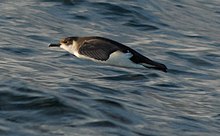Barolo shearwater
| Barolo shearwater | |
|---|---|

| |
| Scientific classification | |
| Domain: | Eukaryota |
| Kingdom: | Animalia |
| Phylum: | Chordata |
| Class: | Aves |
| Order: | Procellariiformes |
| Family: | Procellariidae |
| Genus: | Puffinus |
| Species: | P. baroli
|
| Binomial name | |
| Puffinus baroli (Bonaparte, 1857)
| |
The Barolo shearwater (Puffinus baroli), also known as the North Atlantic little shearwater or Macaronesian shearwater, is a small
Taxonomy
Barolo shearwater was
It was previously considered
Description
Features that distinguish the Barolo shearwater from the Manx shearwater and other North Atlantic Puffinus species include the pale face, silvery panel in the upperwings, shorter more rounded wings, and blue feet.[8] As well as the pale face with the darkly contrasting eye.[9]
Distribution
The Barolo shearwater breeds on the
Behaviour
The Barolo shearwater feeds in the upper 15m of the water column, which is similar to the closely related Audubon's shearwater Puffinus lherminieri of the western Atlantic and Caribbean Sea. Barolo shearwaters do not have a preferred time of day to forage or rest and they may hunt for food during either day or night, although they seem to be more ready to fly in the daylight hours. They feed mainly on fish and cephalopods, with Argonauta argo being the most common cephalopod taken in the Azores but also being part of a diverse selection of cephalopod prey, while the fish taken were almost exclusively Phycis spp.[13]
Threats
Like other Procellariforms, introduced predators (rats and cats) must be their main threats at breeding colonies. In addition, fledglings are attracted to artificial lights at night during their maiden flights from nests to the sea.[14] On Tenerife, Canary Islands, a decline on the number of birds attracted to lights have been reported, suggesting a population decline on the island.[15]
References
- ^ Bonaparte, Charles Lucien (1857). Conspectus Generum Avium (in Latin). Vol. 2. Lugduni Batavorum: Apud E.J. Brill. p. 204.
- ISBN 978-1-4081-2501-4.
- ^ Brisson, Mathurin Jacques (1760). Ornithologie, ou, Méthode Contenant la Division des Oiseaux en Ordres, Sections, Genres, Especes & leurs Variétés (in French and Latin). Paris: Jean-Baptiste Bauche. Vol. 1, p. 56, Vol. 6, pp. 129-130.
- ^ Rasmussen, Pamela, eds. (January 2022). "Petrels, albatrosses". IOC World Bird List Version 12.1. International Ornithologists' Union. Retrieved 19 February 2022.
- JSTOR 4090321.
- .
- .
- ^ McGeehan & Mullarney 1995, Martin & Rowlands 2001.
- ^ "Barolo's Shearwater Puffinus baroli (Bonaparte, 1857)". Wind Birds, Lda. 2005-10-07. Retrieved 10 December 2016.
- S2CID 241706768. Retrieved 19 February 2022.
- ^ "Macaronesian Shearwater (Barolo Shearwater)". www.birdsandcompany.com. Retrieved 10 December 2016.
- hdl:10261/228870.
- hdl:2445/61235.
- hdl:10261/45133.
- hdl:10261/45113.
